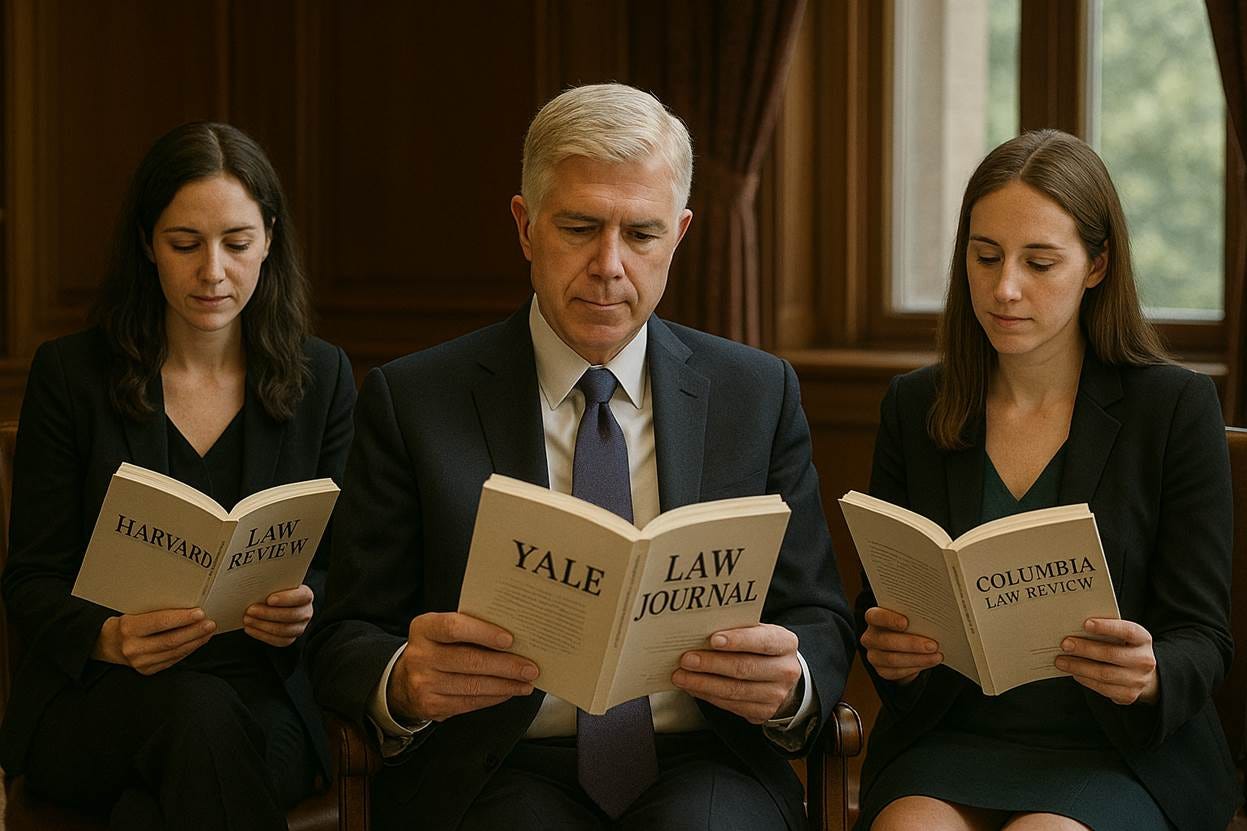SCOTUS’ Law Journal Citation Practices Since Justice Barrett Joined the Court
A look at the authors and journals that most frequently make their ways into the justices’ opinions.
When Chief Justice Roberts, in his majority opinion for West Virginia v. EPA, penned the resonant observation that "Agencies have only those powers given to them by Congress, and 'enabling legislation' is generally not an 'open book to which the agency [may] add pages and change the plot line,’” he was, as revealed in the citation to E. Gellhorn & P. Verkuil's 1999 Cardozo Law Review article, drawing directly from the intellectual arsenal of academic legal scholarship. For Supreme Court Justices, these citations are far more than mere academic niceties; they are a vital toolkit, providing essential historical context, theoretical frameworks, novel arguments, and persuasive authority that can shape the contours of American law. They offer a rich tapestry of perspectives, allowing justices to delve deeper into complex issues, anticipate counter-arguments, and bolster their reasoning with external intellectual weight.
In the following sections, the article embarks through an often-hidden landscape of this scholarly influence, mapping the overall volume of law review citations since the beginning of the 2020 Term, and uncovering the contextual distribution of these references across various types of opinions and pivotal cases. It then delves into the individual citation habits of the justices themselves, exploring the temporal reach of their cited scholarship and the specific academic voices and institutional platforms that resonate most profoundly within their chambers. This analysis conveys the subtle, yet profound, ways the world of legal academia helps write the pages of Supreme Court history.
A broader landscape of Supreme Court engagement with legal scholarship emerges when examining the collective citation patterns to law review articles. The graphs below offer critical topline insights into the sheer volume and contextual distribution of these citations, providing a panoramic view. By analyzing where, and in what types of opinions, law reviews exert their influence, we begin to map the academic bedrock underpinning some of the nation's most pivotal legal decisions.
Each citation was counted once per justice-opinion so they may be counted multiple times if they showed up in multiple opinions even within the same case. A supplementary analysis which then only counted citations once per decision did not lead to significantly divergent findings.
The graph below looks at the cases where law journal articles were cited most prevalently during these years.
The citations by case graph highlights the specific Supreme Court cases that have drawn the most heavily from law review articles. Haaland v. Brackeen stands out as the case with the most such references with 31, closely trailed by Loper Bright Enterprises v. Raimondo at 29, and United States v. Vaello Madero with 25 citations. These high-citation cases represent complex legal questions or novel constitutional challenges where scholarly discourse provides essential context or theoretical grounding. While these leaders dominate, a significant number of other cases also feature scholarly engagement (e.g., New York State Rifle v. Bruen at 23, United States v. Rahimi at 20, Fulton v. City of Philadelphia at 19) down to a consistent baseline of 9-10 citations for cases such as Sackett v. EPA, Jones v. Hendrix, Dobbs v. Jackson Women's Health, and Allen v. Milligan. This broad distribution across many cases underscores the pervasive, albeit varied, role of legal academia in the Court's diverse docket.
Here we see that the justices tend to cite law journal articles most frequently in separate opinions and only a minority of these citations make their way into the majority opinions. One explanation is that the justices seek support from varied sources to make their arguments that do not align directly with the majority’s reasoning.
The sections below detail the justices’ practices and preferences along with the journals and authors cited most frequently.
Whether you are interested in how often the justices cited University of Virginia or Harvard Law Reviews or Michael McConnell’s or Cass Sunstein’s articles, the datapoints are all conveyed below.
The Justices
Before delving into the intricate web of which authors and journals are most frequently cited by individual justices, it's essential to grasp the broader patterns of engagement with legal scholarship. These two foundational graphs illuminate the overall volume of law review citations by each justice and, perhaps more tellingly, the temporal distribution of the articles they choose to highlight. This preliminary insight helps contextualize the subsequent, more granular analyses, revealing not just who cites, but how much they cite, and crucially, from what historical periods of legal thought they draw inspiration, laying the groundwork for understanding the nuanced intellectual influences on the Supreme Court.







